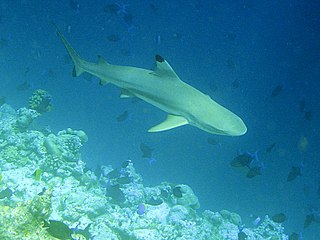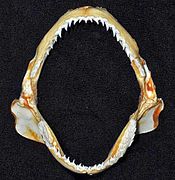
Requiem sharks are sharks of the family Carcharhinidae in the order Carcharhiniformes. They are migratory, live-bearing sharks of warm seas and include such species as the bull shark, lemon shark, blacktip shark, and whitetip reef shark.

The dusky smooth-hound, also called the smooth dogfish or the dog shark, is a species of houndshark in the family Triakidae. This shark is an olive grey or brown in color, and may have shades of yellow or grayish white. Females live to 16 years and males have a lifespan of 10 years. M. canis was the first shark recognised to have viral infections.

The bonnethead, also called a bonnet shark or shovelhead, is a small member of the hammerhead shark genus Sphyrna, and part of the family Sphyrnidae. It is an abundant species in the littoral zone of the North Atlantic and the Gulf of Mexico, is the only shark species known to display sexual dimorphism in the morphology of the head, and is the only shark species known to be omnivorous.

The sharpnose sevengill shark, also known as one-finned shark, perlon shark, sevengill cow shark, sharpsnouted sevengill or slender sevengill, is a species of shark in the family Hexanchidae, and the only living species in the genus Heptranchias. Found almost circumglobally in deep water, it is one of the few species of sharks with seven pairs of gill slits as opposed to the usual five. The other shark species with seven gill slits is the broadnose sevengill shark. Though small, this shark is an active, voracious predator of invertebrates and fish. When caught, this species is notably defensive and will attempt to bite. It is of minor commercial importance.

The blacktip shark is a species of requiem shark, and part of the family Carcharhinidae. It is common to coastal tropical and subtropical waters around the world, including brackish habitats. Genetic analyses have revealed substantial variation within this species, with populations from the western Atlantic Ocean isolated and distinct from those in the rest of its range. The blacktip shark has a stout, fusiform body with a pointed snout, long gill slits, and no ridge between the dorsal fins. Most individuals have black tips or edges on the pectoral, dorsal, pelvic, and caudal fins. It usually attains a length of 1.5 m (4.9 ft).

The daggernose shark is a little-known species of requiem shark, in the family Carcharhinidae, and the only extant member of its genus. It inhabits shallow tropical waters off northeastern South America, from Trinidad to northern Brazil, favoring muddy habitats such as mangroves, estuaries, and river mouths, though it is intolerant of fresh water. A relatively small shark typically reaching 1.5 m (4.9 ft) in length, the daggernose shark is unmistakable for its elongated, flattened, and pointed snout, tiny eyes, and large paddle-shaped pectoral fins.

The blacknose shark is a species of requiem shark, belonging to the family Carcharhinidae, common in the tropical and subtropical waters of the western Atlantic Ocean. This species generally inhabits coastal seagrass, sand, or rubble habitats, with adults preferring deeper water than juveniles. A small shark typically measuring 1.3 m (4.3 ft) long, the blacknose has a typical streamlined "requiem shark" shape with a long, rounded snout, large eyes, and a small first dorsal fin. Its common name comes from a characteristic black blotch on the tip of its snout, though this may be indistinct in older individuals.

The Borneo shark is a species of requiem shark, and part of the family Carcharhinidae. Extremely rare, it is known only from inshore waters around Mukah in northwestern Borneo, though it may once have been more widely distributed. A small, gray shark reaching 65 cm (26 in) in length, this species is the only member of its genus with a row of enlarged pores above the corners of its mouth. It has a slender body with a long, pointed snout and a low second dorsal fin placed posterior to the anal fin origin.

The finetooth shark is a species of requiem shark, in the family Carcharhinidae, found in the western Atlantic Ocean, from North Carolina to Brazil. It forms large schools in shallow, coastal waters, and migrates seasonally following warm water. A relatively small, slender-bodied shark, the finetooth shark can be identified by its needle-like teeth, dark blue-gray dorsal coloration, and long gill slits. It attains a maximum length of 1.9 m (6.2 ft). The diet of this species consists primarily of small bony fishes, in particular menhaden. Like other members of its family, it is viviparous with females giving birth to two to six pups in estuarine nursery areas every other year.

The smalltail shark is a species of requiem shark, and part of the family Carcharhinidae. It is found in the western Atlantic Ocean, from the northern Gulf of Mexico to southern Brazil. It inhabits shallow waters close to shore, particularly over muddy bottoms around estuaries. It tends to swim low in the water column and forms large aggregations segregated by sex. A slim species generally not exceeding 1.1 m (3.6 ft) in length, the smalltail shark has a rather long, pointed snout, a broad, triangular first dorsal fin, and a second dorsal fin that originates over the midpoint of the anal fin base. It is plain gray in color, without prominent markings on its fins.

The milk shark is a species of requiem shark, and part of the family Carcharhinidae, whose common name comes from an Indian belief that consumption of its meat promotes lactation. The largest and most widely distributed member of its genus, the milk shark typically measures 1.1 m (3.6 ft) long, and can be found in coastal tropical waters throughout the eastern Atlantic and the Indo-Pacific regions. Occurring from the surface to a depth of 200 m (660 ft), this species is common near beaches and in estuaries, and has been recorded swimming up rivers in Cambodia. Juveniles are known to inhabit tidal pools and seagrass meadows. The milk shark has a slender body with a long, pointed snout and large eyes, and is a nondescript gray above and white below. This shark can be distinguished from similar species in its range by the long furrows at the corners of its mouth, and seven to 15 enlarged pores just above them.

The Brazilian sharpnose shark is a requiem shark of the family Carcharhinidae. It is found in the tropical waters of the western Atlantic Ocean between latitudes 13° N and 33° S, at depths between 3 and 70 m. It has been recorded in the following countries: Aruba, Brazil, Colombia, French Guiana, Guyana, Panama, Suriname, Trinidad and Tobago and Venezuela. It can reach a length of 77 cm. It is considered a vulnerable species in Brazil due to intensive fishing although it may actually classify at a higher level. The flesh is eaten for food but the fins are not used as they are too small. Other threats include water pollution from plastic litter and three specimens have been found with plastic collars on their head or gills. The shark feeds on teleostei and squid. Research showed the shark may be an important predator of demersal and pelagic prey.

The Pacific sharpnose shark often migrates along the Pacific coast of Mexico. They are most commonly caught in the artisanal fishery of Mazatlán. When a large sample of Pacific sharpnose sharks were observed scientists concluded that this type of shark was a "viviparous shark of small size which is born at an average length of 31 cm." Their gestation period is between ten and eleven months.

The grey sharpnose shark is a requiem shark of the family Carcharhinidae. It is found in the tropical waters of the Indo-West Pacific Oceans, between latitudes 30° N and 18° S, from the surface to a depth of 36 m. It can reach a length of about 70 cm.

The Australian sharpnose shark is a requiem shark, belonging to the family Carcharhinidae. It is found in the tropical waters of the western Pacific Ocean off Papua New Guinea and northern Australia, between latitudes 8°N and 28°S, from the surface to a depth of 110 m. It can grow up to a length around 70 cm. The Australian sharpnose shark is well known for its fast growth rate, which allows it to reach maturity at around one year of age.

The Atlantic sharpnose shark is a species of requiem shark in the family Carcharhinidae. It is found in the subtropical waters of the north-western Atlantic Ocean, between latitudes 43°N and 18°N.

Rhizoprionodon is a genus of requiem sharks, and part of the family Carcharhinidae, commonly known as sharpnose sharks because of their long, pointed snouts.

The Caribbean roughshark is a rough shark of the family Oxynotidae, found on the upper continental slopes of the Caribbean Sea, at depths between 400 and 450 m. It reaches a length around 50 cm (20 in).

The velvet belly lanternshark is a species of dogfish shark in the family Etmopteridae. One of the most common deepwater sharks in the northeastern Atlantic Ocean, the velvet belly is found from Iceland and Norway to Gabon and South Africa at a depth of 20–2,490 m (66–8,169 ft). A small shark generally no more than 45 cm (18 in) long, the velvet belly is so named because its black underside is abruptly distinct from the brown coloration on the rest of its body. The body of this species is fairly stout, with a moderately long snout and tail, and very small gill slits. Like other lanternsharks, the velvet belly is bioluminescent, with light-emitting photophores forming a species-specific pattern over its flanks and abdomen. The ventral photophores are thought to function in counter-illumination, which camouflages the shark against predators and prey. The bioluminescent flank markings may play a role in intraspecific communication.

The starry smooth-hound is a houndshark of the family Triakidae. It is found on the continental shelves of the northeast Atlantic, between latitudes 61 and 16° N, from the surface to a depth of 200 m (660 ft).
























